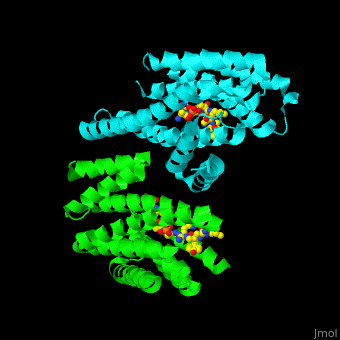Introduction
The 14-3-3 proteins (PRS) are a family of highly conserved regulatory proteins found in all eukaryotic organisms. They are involved in diverse cellular processes, including signal transduction, cell cycle control, protein trafficking, apoptosis (programmed cell death), and various other regulatory functions. The name "14-3-3" refers to the initial method used to identify and separate these proteins based on their migration pattern during gel electrophoresis. The proteins migrate at approximately 30 kDa, giving the impression of a molecular weight of 14-3-3 [1]
Function
One of the key features of 14-3-3 proteins is their ability to interact with a wide range of target proteins, often through phosphorylation-dependent mechanisms. They typically bind to target proteins that contain a specific phosphoserine or phosphothreonine motif. This interaction can alter the target protein's activity, stability, subcellular localization, or protein-protein interactions, thereby influencing various cellular processes.
The binding of 14-3-3 proteins to their target proteins can have diverse functional outcomes. It can either activate or inhibit the target protein, modulate its interactions with other proteins, protect it from degradation, or act as a scaffold for protein complex formation. By regulating the activity and localization of their target proteins, 14-3-3 proteins exert tight control over cellular signaling and contribute to the coordination of complex cellular processes.
These proteins are highly context-dependent and vary depending on the specific isoform, cellular location, and interacting partners. They have been implicated in numerous physiological and pathological processes, including neuronal development and function, cell cycle regulation, apoptosis, cancer progression, and neurodegenerative diseases.
Research on 14-3-3 proteins continues to uncover their intricate roles in cellular signaling and their involvement in various diseases. Understanding their interactions and regulatory mechanisms provides insights into fundamental cellular processes and offers potential avenues for therapeutic interventions.
Disease
Elevated levels of PRS are found in patients with Creutzfeld-Jakob disease (CJD). PRS are associated with Parkinson Disease (PD) and with Alzheimer Disease (AD) based on their localization and their binding to PD and AD-associated proteins.
Relevance
PRS are tested as biomarkers for CJD, PD and AD.
Structural highlights
PRS are homo- and heterodimers containing . Three of the helices form the (3 helices of chain A are in red and 3 helices of chain B are in magenta). .
3D structures of 14-3-3 protein
14-3-3 protein 3D structures

